GENERAL EQUIPMENT
General equipment.Autodoc
AUTODOCWhere is a dang medic when you need one? Are you tired
of having to hire medics all the time to keep adventurers
on the top side of the soil? Are you tired of their selfrighteous
know-it-all attitude? Who is a medic gonna call
when they get shot? Well look no further. Just dump your
shot-up buddy in the autodoc, and it will fix him right up.
Got a bad hangover? A sunburn? or even a dismembered
leg? Just hop in the autodoc. No job is too small or too big.
The Autodoc or "Coffin" is a level 6 autonomous medical
robot that can provide most services that a medical
professional can provide. The autodoc consists of an
airtight capsule, where the character is placed. It is
usually made of glass for observation. It also has built-in
storage for instruments and storage for drugs and gases
used during procedures.
USING THE AUTODOC
The injured or sick character is placed inside. The autodoc
assesses and diagnoses the problem. Then administers the
appropriate treatment. The autodoc will sedate the
character during treatment. They will be totally
unconscious during any procedures.
A character that has not gone below -30 stamina can be
placed in the autodoc. They will be stabilized and field
surgery will be performed. The auotdoc makes a skill
check for each treatment of skill level of 6. It will first do a
diagnosis. Then it will determine whether first aid, minor
surgery or major surgery is needed to heal the character.
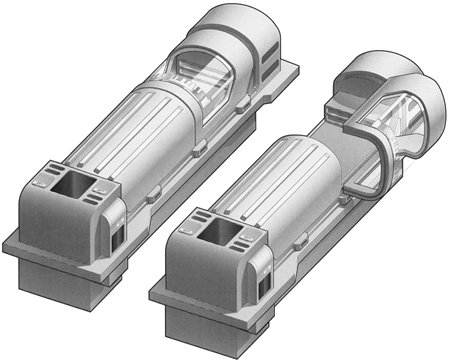
Characters who are poisoned or infected: a skill check of
controlling infection then cure disease will be
administered. The character will not be released until all
Stamina points are restored.
A maximum of 20 stamina points per day can be restored.
The autodoc artificial intelligence can be convinced to
modify treatment or to release a patient early if there is a
legitimate reason. (i.e. The ship will blow up, or there is
another patient that will die.) Of course this is up to the
Referee’s discretion what type of logic or personality the
doc will have.
If the character has sustained a dismemberment of arm,
leg, finger, etc. the part can be put into the autodoc for
reattachment. Success on this varies.
If any skill checks fail for treatment the autodoc will
instantly put the patient in a freeze field. It will not release
the freeze field until the patient is brought to an advanced
facility for treatment.
Autodocs are species-specific or can be modified with
software and instruments for other races.
Autodocs can be used singularly or can be run in a
succession of several capsules. They were used to good
effect in the first Sathar war. The Marine carrier ship
Januus used an autodoc with a series of 200 capsules on
board for emergency battle treatment.
The autodoc will give a complete diagnostic of the
character in its care and give the time for treatment and
causes etc. It can also provide an autopsy of a dead
character. These are provided through voice or by
printout. The autodoc will converse with the characters to
discuss treatment (provide options, etc.).
POWER AND STRUCTURE
The autodocs usually have a constant power source (such
as a permanent installation, starship or a large vehicle),
although a parabattery or generator can be used. The
power usage is 20 SEU per day. The 'doc can be
temporarily disconnected from the main power source and
moved. Provided another power source is connected within
10 minutes. It is completely sealed and is insulated from
adverse weather and the vacuum of space.
The autodoc can withstand 100 points of damage before it
will not operate. If the doc has sustained damage the
capsule will remain locked. It will take a tech to defeat
security or another 30 points to the locking mechanism to
get at any patients.
MAINTENANCE
The autodoc must have a power supply to operate. The
autodoc can heal up to 500 stamina before it needs an
overhaul. This will cost 1,000 credits, and must be done at
a major hospital.
Autodoc. Cost 50,000, Extra capsules 10,000 (can add up to 10 capsules to one doc.), Comes with software for 1 species. Additional species programs and equipment are 5,000 ea. Size: 1.5 meters x 2.5 meters x 1 meter tall, Mass: 200 kg.
Duraraft
Duraraft
Cost 90 Cr
Wgt 3kg
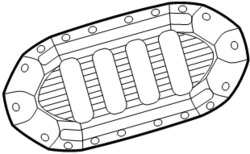
This tiny 3kg pouch-sized kit can be inflated (automatically when activated) into a fully-functional four-man raft. It takes about five minutes to inflate, and a similar amount of time to deflate.
When deconstructed and properly stowed, it fits in a small pack that straps to the thigh for easy transport.
Envirotent
Envirotent
Cost 40 Cr
Wgt 3kg
This tiny 3kg pouch-sized kit can be erected into a small 3-man habitat tent in about ten minutes. It takes a similar amount of time to deconstruct. It can come in a variety of colors.
When deconstructed and properly stowed, it fits in a small pack that straps to the thigh for easy transport.
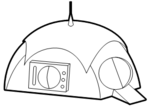
Jumpboots
Jumpboots
Cost 70 Cr
Wgt --
These appear to be a normal mundane set of boots, rugged-looking and easy on the foot. Concealed in the heel, however, is a tiny explosive charge.
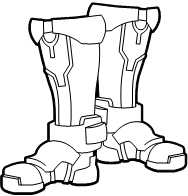
When the wearer presses certain buttons on the boots, the charge becomes active. When the character jumps down hard on an active Jumpboot, the charge fires, and a concussive blast is heard for about a kilometer. The concussion launches the character into the air and improves his leaping distance by a multiple of 3. After the explosive blast, the boot acts as a normal boot. The charge cannot normally be re-set, it is part of the boots manufacturing process.
Using these boots in combat is not wise, both participants will be knocked 1d10 meters in opposite directions, and both will take 3d10 damage.
Mine Kits
by [[Larry Moore]]
Star Frontiersman #5-p1
These mine kits could be purchased for any type of grenade. Tangler mines are set in place and activated, then have special sensors (see below) to determine when they should detonate. They make fantastic perimeter defenses and non-lethal wards against intrusion.
A mine kit has two parts. First is the grenade itself, which mounts into the kit. Second is the sensory cluster, which act as the method of detonation (replacing whatever “delivery” type the grenade had previously). There are six basic types of tangler mine sensor clusters, as shown below:
Pressure Sensor – This is the standard, classic form of mine sensor cluster. It assumes the mine will be buried into the ground or under debris. It has a simple weight cell that relays analog weight levels back to a central processor, where it compares the detected weight against the sensitivity adjustment set during the setting of the charge. It takes 5 turns to dig, bury, cover, perform a weight tare, calibrate the setting, and conceal. Any creature equaling or exceeding the weight setting will detonate the grenade and be tangled. If desired, the mine’s detonation can be delayed 2 turns after the weight is released, in an attempt to entangle a larger group being followed by a party’s scout who set it off.
Proximity Sensor – This sensor can come in one of two forms: electromagnetic proximity sensor or laser-eye sensor. The electromagnetic sensor detects the presence of an electric field, either a bioelectric field generated by a living being or an activated defense screen (such as a sonic screen concealing the noises of an approaching intruder!). The laser-eye sensor is actually a beam and a receiver, which wirelessly reports data safely back to the mine central processor through a simple radio frequency transmitter/receiver pair. The mine will detonate if it detects the light beam is broken or the signal is somehow interrupted. It takes 2 turns to properly set and calibrate a mine equipped with a proximity-sensor cluster.
Motion Sensor – Using technology similar to the Motion Tracker (see this issue’s Equipment article), this sensor cluster detects movement in the proximity of the mine. It can be calibrated to filter out repetitive motion (such as rotating satellite antennae) and can even have filters put in place to define minimum and maximum speeds and sizes of detected motion. When the proper sized object or creature moves at the proper speed, it will detonate the tangler. It takes 2 turns to set and calibrate a filter array for a mine equipped with a motion sensor cluster.
Time Delay – Instead of a sensor, this cluster simply comes with a series of dials and buttons used to set a desired countdown. It can be set from 0 to 999 and can have hours, minutes, or seconds selected. Once selected and the “Initiate” button is pressed, the countdown begins. When it’s done, the grenade in the mine kit will be detonated. Although not commonly used with Tangler grenades, it certainly could be. It takes only a single turn to set a mine equipped with a time delay delivery cluster.
Photon Sensor – This type of sensor is set to detect either light or lack thereof, depending on the presence or lack of light in the turn directly following the turn in which it is set. Thus, if it is dark when the mine is set, the mine will detonate as soon as light becomes present. If it is light when the mine is set, it will detonate when darkness is detected. This can be used as a booby trap: simply place in a dark room near the door, and when the door is opened and the light in the hallway pours in, the person opening the door will be surprised. It takes only one turn to set a mine equipped with a photon cluster.
Voice Recognition Cluster – This very modern cluster has a programmable logic controller that is programmed by simple voice recognition pattern. Simple commands are used to set and define its operation. It is very expensive to purchase and is destroyed by the mine’s detonation (as are all sensor clusters). The character setting the mine simply speaks his command set to the mine “Mine. Activate. Motion Sense. One meter movement size. Ten meter minimum movement rate. One hundred meter maximum movement rate. Initiate.” Its operation can be set to do any of the above sensor cluster types. It’s also possible to set up exclusion rules (identification of friend or foe: IFF transponders) so allies never get affected. Voice Recognition Clusters are also quite difficult to defuse because they require programming knowledge to identify how they’ve been set. It takes only a single turn to set a mine equipped with a voice recognition cluster.
|
Mine Kit Equipment |
Cost (CR) | Weight | Turns to set |
| Mine Kit* | 20 | 1kg | -- |
| Sensor Cluster | |||
| Motion | 40 | 1kg | 2 |
| Pressure | 35 | 1kg | 5 |
| Proximity | 45 | 1kg | 2 |
| Time Delay | 25 | 1kg | 1 |
| Voice | 150 | 1kg | 1 |
| Photon | 20 | 1kg | 1 |
Survival Kit
Survival Kit
Cost 150 Cr
Wgt 6kg
This is an emergency survival kit. It is similar to the Standard Equipment Pack from the main rules book, but reformatted to make it useful for explorers and wilderness scouts (and anyone finding themselves stranded on a desert planet!). Many lifeboats and escape pods have a number of these survival kits stowed, as well as a single duraraft and envirotent.
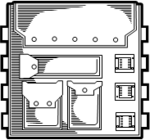
The Survival Kit consists of the following items:
- All-weather blanket
- Basic first-aid equipment (bandages, etc.)
- Compass
- Everflame
- Gas Mask
- Holoflare
- Life Jacket
- Pocket Flashlight
- Pocket Tool
- Rope
- Sungoggles
- Survival Rations (5 days)
- Toxy-rad guage
- Waterpack
Visocom
Visocom
Cost 50 Cr
Wgt --
This is a hands-free version of the communicator built into a standard chronocom. It lacks any timekeeping technology, and attaches to a standard pair of sungoggles, magnigoggles, or Infra-red goggles. It has the same range as the chronocom (5km). Just like the chronocom, it has a standard identification number that can be given to others to enable them to “call” you.
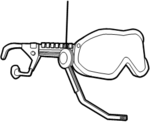
To call another visocom or chronocom, simply touch a finger to the side of the boom mic/ear piece combination device, and clearly speak the identification number of the person you wish to call. It can also be put in a conference mode, where any number of visocoms and chronocoms can maintain an open channel for free communication among one another.
Visocoms are less expensive than their chronocom partners because they don’t keep track of time, are more obvious, and lack the micronization required to fit the technology into a wristwatch.
Wide-Field Recorder
Wide-Field Recorder
Cost 100 Cr
Wgt --
This sphere can hover and record all visual and audio activity in a 360 degree radius. It takes a standard 20 SEU clip and drains 1 SEU per hour. The recording is stored on a small micro-disc that can be read on most computer systems. A disc holds 20 hours of data, and extra discs can be purchased for 20 Credits. It comes in a shoulder worn carry bag complete with interface cables and a place to store 2 extra micro-discs and 2 extra SEU power clips. It cannot be connected to any other power source.
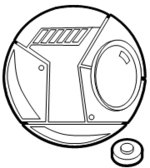
Later, when looking at the data recorded from the Wide-Field Recorder, a computer specialist can pan around, zoom in, filter out noise, and recreate the entire three dimensional experience recorded on the micro-disc. With proper holographic projection equipment, a fairly realistic scene can be reproduced.
Unfortunately, it is also possible for a skilled computer specialist to tamper with the data contained on the disc, making this device not admissible in most courts.